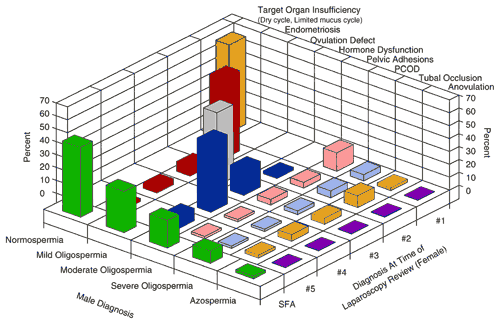
Infertility is a symptom of underlying disease. The diseases that cause infertility have a “two-pronged” effect. They not only hinder the functioning of fertility, but they also cause both short and long-term health problems. The persistent unwillingness to address infertility problems from this point of view or perspective is one of the major flaws in the current approach to the treatment of infertility.
Fertility problems also carry with them significant emotional sequelae. This is fairly well recognized by those who work in this field and psychosocial distress can contribute significantly to the cause of some forms of infertility.
Until 1978, most of the effort in medicine in evaluating and treating women with infertility was placed in trying to identify and treat the underlying causes. In 1978, in vitro fertilization produced a paradigm shift. It led to a “skipping over” the causes and this continues up to the present time to be the foundational management approach. In essence, this is a symptomatic or Band-Aid approach to treatment, not one that gets to the root causes. When the artificial reproductive technologies began to take hold, now over 25 years ago, diagnostic laparoscopy was in its infancy. Hormone assessment, while available, was not readily accessible. Ultrasound technology was still mired in sector scanning and real-time ultrasonography was not yet available. Selective hysterosalpingography had not yet been developed and the fallopian tubes could not be catheterized. The Creighton Model FertilityCare™ System began its first Allied Health Education Program for FertilityCare™ Practitioners (FCP) in 1978. This means of objectively monitoring the biomarkers of the menstrual and fertility cycle was only in its beginning stages. With the availability of the CrMS, observations of mucus patterns during the course of the menstrual and fertility cycle could be observed for the very first time. In fact, information obtained by women charting their cycles in this fashion is unique and can only be obtained in this fashion. In Figure 40-2, a normal cycle with a normal mucus pattern, Peak Day and post-Peak phase is illustrated. In addition, the estrogen levels (black bars) and progesterone levels (red bars) are also shown to demonstrate the correlation to underlying hormonal events.
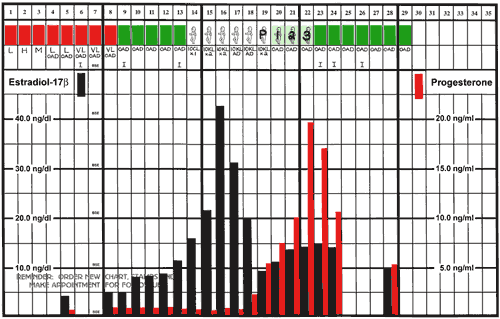
In the next cycle, a completely dry cycle is observed. No mucus is observed during the course of the entire cycle. These dry cycle patterns occur in about 15 percent of all women with regular cycles and infertility. Looking at the underlying hormonal correlations (Figure 40-3), one can see that the estrogen and progesterone levels are significantly suboptimal compared to the levels observed in the normal cycle (Figure 40-2). This suggests that the dry cycles – the absence of mucus – are a reflection of underlying hormonal abnormalities. We now know that this is an exhibition of abnormal folliculogenesis and abnormal luteogenesis (abnormal development of the follicle with a subsequent abnormal corpus luteum). This is also associated with abnormal ovulation events.
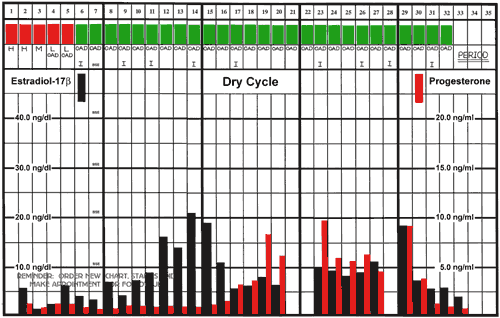
The Goals of NaProTECHNOLOGY in Infertility
A NaProTECHNOLOGY approach to the infertile couple has the following goals:
- It works towards assessing the underlying causes of the reproductive abnormality.
- It allows for the treatment of these underlying causes.
- It assists the couple in achieving pregnancy while maintaining the natural acts of procreation.
- If the treatment program is unsuccessful, research into the unknown causes is undertaken.
- If medically unsuccessful, the program will assist with successful family building by being supportive of adoption.
The use of a NaProTECHNOLOGY approach to infertility or miscarriage will also allow us to observe events that formerly had been ignored. An example of this might be that found in Figure 40-7. Here a woman with four consecutive miscarriages has charted her cycle. She has multiple days of premenstrual spotting prior to the beginning of her next period. The hormonal correlation shows a significantly reduced progesterone production by the corpus luteum suggesting an inadequate corpus luteum as one of the underlying causes of her repetitive miscarriages.
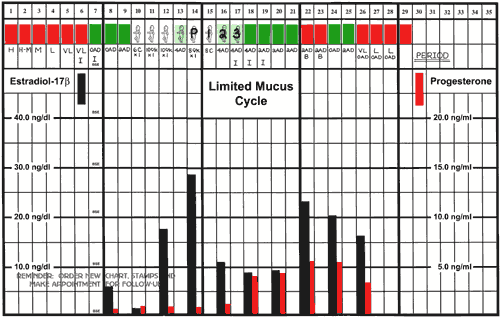
A staircase approach outlining the basic principles of NaProTECHNOLOGY for the evaluation and treatment of infertility is shown in Figure 40-8.
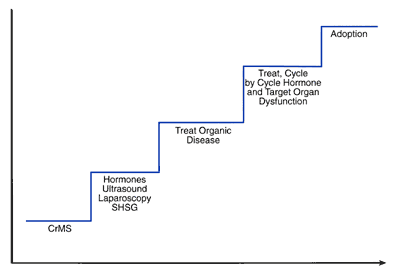
Several examples of successful outcomes in patients with infertility are shown in the next series of charts.
Case No. 1: In this patient with dry cycles and seven years of infertility, Vitamin B6 was recommended as a mucus enhancing supplement. In the last cycle, limited mucus was observed and pregnancy achieved without any additional assistance except fertility-focused intercourse (from Saint Paul VI Institute research, 2004).
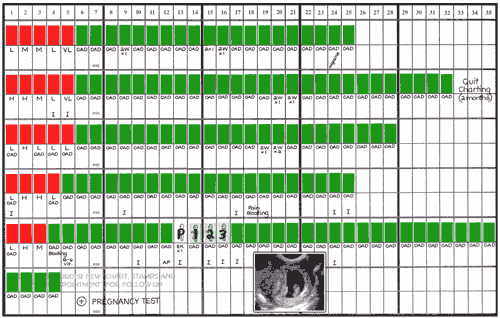
Case No. 2: In this case, the patient, who previously lost sextuplets from an ART procedure at nearly 20 weeks of pregnancy, shows here CrMS chart which is strikingly consistent with polycystic ovarian disease (Figure 40-25).
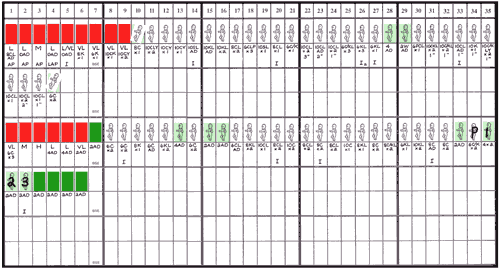
Case No. 3: The limited mucus cycles, endometriosis, ovarian dysfunction and a husband with a very low sperm count were identified in this patient who had failed two previous IVF procedures. In spite of these abnormalities, with proper NaProTECHNOLOGY treatment, she achieved a pregnancy and had a normal healthy baby (from Saint Paul VI Institute).
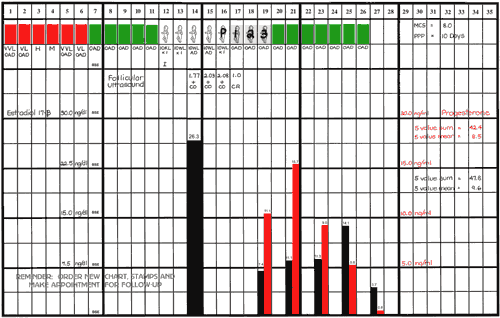
Effectiveness For Infertility Treatment
Using a NaProTECHNOLOGY approach for the treatment of infertility can be highly effective and even more effective than current approaches to infertility. In Figure 51-5, a life table comparison of the effectiveness of NaProTECHNOLOGY (in blue) with a similar non-NaProTECHNOLOGY approach taken at Johns Hopkins University is shown. The success rates are clearly better using the NaProTECHNOLOGY approach.

A similar study showing a comparison of a NaProTECHNOLOGY approach to the treatment of women who have polycystic ovarian disease and comparing it to the work at Johns Hopkins University also shows a significant improvement (Figure 51-13).
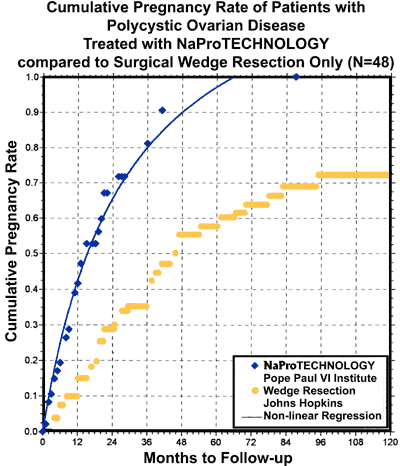
In Figure 51-38, a comparison is made of the “per woman” pregnancy rates between the NaProTECHNOLOGY approach and in vitro fertilization. This study shows that a NaProTECHNOLOGY approach for women who have anovulatory infertility, polycystic ovarian disease, endometriosis, or tubal occlusion, all have statistically significantly higher pregnancy rates than patients with similar conditions treated with in vitro fertilization.
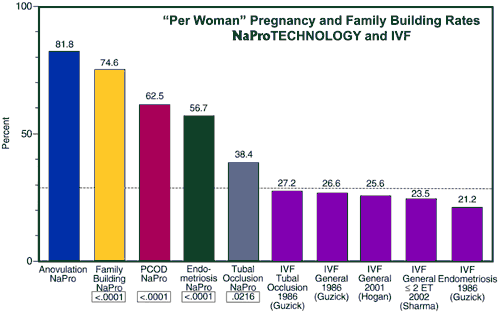
Diagnosis of Infertility
A diagnostic grid showing both the female and the male diagnosis in patients with primary and secondary infertility is shown in a group of 660 couples who have been through the complete NaProTECHNOLOGY evaluation process. This is shown in Figure 40-23.
